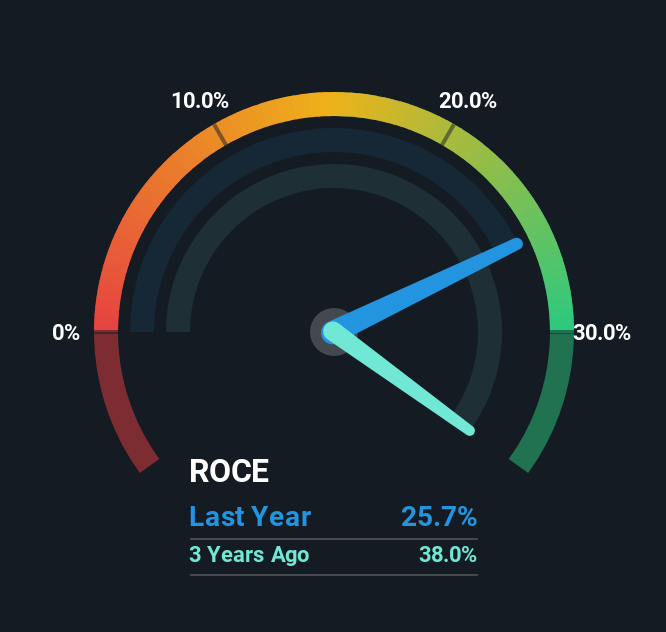- United Arab Emirates
- /
- Infrastructure
- /
- DFM:SALIK
Capital Allocation Trends At Salik Company P.J.S.C (DFM:SALIK) Aren't Ideal
If you're not sure where to start when looking for the next multi-bagger, there are a few key trends you should keep an eye out for. Firstly, we'll want to see a proven return on capital employed (ROCE) that is increasing, and secondly, an expanding base of capital employed. Ultimately, this demonstrates that it's a business that is reinvesting profits at increasing rates of return. Looking at Salik Company P.J.S.C (DFM:SALIK), it does have a high ROCE right now, but lets see how returns are trending.
What Is Return On Capital Employed (ROCE)?
For those who don't know, ROCE is a measure of a company's yearly pre-tax profit (its return), relative to the capital employed in the business. To calculate this metric for Salik Company P.J.S.C, this is the formula:
Return on Capital Employed = Earnings Before Interest and Tax (EBIT) ÷ (Total Assets - Current Liabilities)
0.26 = د.إ1.8b ÷ (د.إ8.1b - د.إ1.1b) (Based on the trailing twelve months to June 2025).
Thus, Salik Company P.J.S.C has an ROCE of 26%. In absolute terms that's a great return and it's even better than the Infrastructure industry average of 6.3%.
View our latest analysis for Salik Company P.J.S.C

In the above chart we have measured Salik Company P.J.S.C's prior ROCE against its prior performance, but the future is arguably more important. If you'd like to see what analysts are forecasting going forward, you should check out our free analyst report for Salik Company P.J.S.C .
So How Is Salik Company P.J.S.C's ROCE Trending?
In terms of Salik Company P.J.S.C's historical ROCE movements, the trend isn't fantastic. Historically returns on capital were even higher at 38%, but they have dropped over the last three years. Although, given both revenue and the amount of assets employed in the business have increased, it could suggest the company is investing in growth, and the extra capital has led to a short-term reduction in ROCE. If these investments prove successful, this can bode very well for long term stock performance.
On a related note, Salik Company P.J.S.C has decreased its current liabilities to 14% of total assets. That could partly explain why the ROCE has dropped. Effectively this means their suppliers or short-term creditors are funding less of the business, which reduces some elements of risk. Since the business is basically funding more of its operations with it's own money, you could argue this has made the business less efficient at generating ROCE.
The Bottom Line On Salik Company P.J.S.C's ROCE
While returns have fallen for Salik Company P.J.S.C in recent times, we're encouraged to see that sales are growing and that the business is reinvesting in its operations. And long term investors must be optimistic going forward because the stock has returned a huge 184% to shareholders in the last three years. So while the underlying trends could already be accounted for by investors, we still think this stock is worth looking into further.
If you'd like to know about the risks facing Salik Company P.J.S.C, we've discovered 1 warning sign that you should be aware of.
If you'd like to see other companies earning high returns, check out our free list of companies earning high returns with solid balance sheets here.
New: Manage All Your Stock Portfolios in One Place
We've created the ultimate portfolio companion for stock investors, and it's free.
• Connect an unlimited number of Portfolios and see your total in one currency
• Be alerted to new Warning Signs or Risks via email or mobile
• Track the Fair Value of your stocks
Have feedback on this article? Concerned about the content? Get in touch with us directly. Alternatively, email editorial-team (at) simplywallst.com.
This article by Simply Wall St is general in nature. We provide commentary based on historical data and analyst forecasts only using an unbiased methodology and our articles are not intended to be financial advice. It does not constitute a recommendation to buy or sell any stock, and does not take account of your objectives, or your financial situation. We aim to bring you long-term focused analysis driven by fundamental data. Note that our analysis may not factor in the latest price-sensitive company announcements or qualitative material. Simply Wall St has no position in any stocks mentioned.
About DFM:SALIK
Salik Company P.J.S.C
Designs, constructs, operates, and maintains the toll gates in Dubai.
Proven track record with moderate growth potential.
Market Insights
Community Narratives



